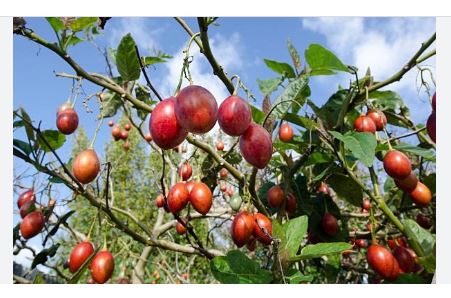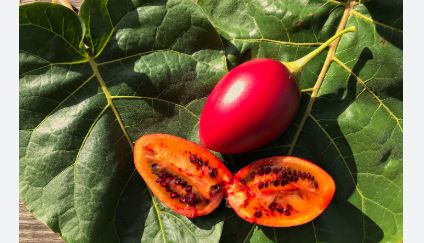
The tamarillo, scientifically classified as Solanum betaceum (formerly Cyphomandra betacea), belongs to the Solanaceae family, commonly known as the nightshade family. This family includes familiar plants like tomatoes (Solanum lycopersicum), potatoes (Solanum tuberosum), and eggplants (Solanum melongena). The genus Solanum is vast, with over 1,500 species, and tamarillo’s reclassification from Cyphomandra reflects modern genetic and morphological studies aligning it closer to true Solanum species. Native to the Andes, it’s a subtropical shrub or small tree, distinguished by its egg-shaped fruit and relation to other edible nightshades.
Tamarillo likely originated in the Andean highlands of Peru, Ecuador, Bolivia, and Chile, though its wild ancestors are elusive, suggesting early domestication by Indigenous peoples. It’s considered one of the “lost crops of the Incas,” with evidence of cultivation predating European contact, though exact timelines remain speculative. By the 16th century, it had spread across South America, naturalizing in Colombia, Brazil, and Venezuela. Europeans encountered it during colonial exploration, but it gained prominence in New Zealand in the late 19th century after seeds arrived from Asia and South America. Renamed “tamarillo” in 1967 by the New Zealand Tree Tomato Promotions Council to distinguish it from tomatoes and boost its exotic appeal, it became a commercial crop there, peaking post-World War II when vitamin C-rich fruits were scarce.
Tamarillo is a fast-growing, evergreen or semi-deciduous shrub or tree, reaching 10-18 feet (3-5.5 meters) tall, with brittle, shallow roots and large, heart-shaped leaves (4-13 inches long) that emit a musky odor. Its flowers, small and fragrant (pale pink to lavender), bloom in clusters from spring, giving way to egg-shaped fruits (2-4 inches long, 1.5-2 inches wide) that hang like ornaments. The skin varies—red, yellow, orange, or purple—often with faint stripes, and is tough and bitter, typically peeled before eating. The flesh ranges from orange-red to yellow, with a juicy, seed-filled pulp (black in darker fruits, yellow in lighter ones) surrounding larger, flatter seeds than a tomato’s. The taste is tangy and mildly sweet, blending tomato-like tartness with notes of passion fruit or apricot; yellow varieties are sweeter, red ones more sour.
Solanum betaceum thrives in subtropical climates, best suited to USDA zones 10-11, where temperatures stay above 50°F (10°C) for consistent fruiting. It can tolerate brief dips to 28°F (-2°C) with some leaf loss, but frost damages young plants and halts growth below this threshold. In zones 8-9, it’s grown as a container plant, brought indoors during winter, as its shallow roots and frost sensitivity limit outdoor survival in cooler climates. It prefers full sun (6-8 hours daily), though partial shade helps in scorching heat, and well-drained, fertile soil enriched with compost. In its native Andes and New Zealand, it flourishes at elevations of 5,000-10,000 feet, avoiding hot, lowland tropics where fruit set falters.

Health Benefits of Tamarillo (Tree Tomato)
- Vitamin C Boost: Rich in vitamin C (up to 40 mg per 100 g), tamarillo supports immunity, skin health, and collagen production, acting as a potent antioxidant.
- Antioxidant Power: Contains anthocyanins (in red varieties) and carotenoids (in yellow ones), which combat oxidative stress, reducing inflammation and chronic disease risk.
- Fiber for Digestion: Offers dietary fiber (about 3-4 g per fruit), promoting healthy digestion, preventing constipation, and supporting gut health.
- Low-Calorie Energy: Low in calories (around 30-40 per fruit) yet high in vitamins A and E, it provides energy and supports vision and skin without adding weight.
- Heart Health: Supplies potassium (300-400 mg per 100 g) and minimal sodium, aiding blood pressure regulation and cardiovascular function.
Culnary Uses of Tamarillo (Tree Tomato) Fruit
- Fresh Eating: Peeled and sliced, tamarillo’s tangy-sweet flesh is enjoyed raw as a snack or in fruit salads, often sprinkled with sugar to balance its tartness.
- Jams & Chutneys: Cooked down with sugar, its pulp makes vibrant jams, jellies, or chutneys, pairing well with meats or cheeses due to its tomato-like acidity.
- Desserts: Blended into smoothies, pureed for sorbets, or baked into cakes and pies, tamarillo adds a unique, fruity flavor to sweets.
- Sauces & Salsas: Its juicy flesh is used in savory sauces or salsas, complementing fish, chicken, or spicy dishes with a tart, tropical twist.
- Juices & Drinks: Juiced or blended with water and sweetener, tamarillo creates refreshing beverages or cocktail bases, showcasing its bold taste.
Cultivation of Tamarillo (Tree Tomato)
- Climate: Tamarillo thrives in subtropical climates with mild temperatures between 60-75°F (15-24°C). It prefers cool nights and warm days but struggles in extreme heat or frost.
- USDA Zones: Best suited to USDA zones 10-11, where frost is rare. In zones 8-9, it can be grown with winter protection (e.g., indoors or under cover), as it tolerates brief dips to 28°F (-2°C) but not prolonged cold.
- Soil: Requires well-drained, fertile soil with a pH of 5.5-7.0. Enriching with compost or manure boosts growth, though it tolerates poorer soils if drainage is good.
- Sunlight: Needs full sun (6-8 hours daily) for optimal fruiting, though partial shade helps in hot climates to prevent leaf scorch or fruit sunburn.
- Planting: Propagate from seeds (slow, 3-5 years to fruit) or cuttings (faster, 1-2 years). Space plants 6-10 feet apart to allow for their 10-18 foot mature height; stake young plants to support brittle branches.
- Watering: Requires consistent moisture—1-2 inches weekly—especially during flowering and fruiting, but overwatering leads to root rot. Mulch retains soil moisture and keeps roots cool.
- Support: Brittle branches need staking or trellising, especially when fruit-laden, to prevent snapping in wind. Prune annually to maintain shape and remove suckers for better airflow.
- Pollination: Small, pink-to-lavender flowers are self-fertile, blooming in spring or fall depending on climate. Bees aid pollination, but shaking branches or hand-pollination ensures fruit set in low-pollinator areas.
- Pests: Susceptible to aphids, whiteflies, and fruit flies. Use neem oil or insecticidal soap, and net fruit to deter birds and flies drawn to ripening berries.
- Diseases: Prone to fungal issues like powdery mildew and root rot in humid or wet conditions. Ensure good drainage, avoid overhead watering, and apply fungicides if needed.
- Harvest: Fruits ripen 6-9 months after flowering (often late summer to fall), turning red, yellow, or purple when ready. Harvest when slightly soft with a gentle twist; yields can reach 20-40 pounds per mature plant annually.
- Yield: A single tree produces fruit within 18-24 months from cuttings, peaking at 4-5 years with 20-50 fruits per season. Lifespan is 5-12 years; replace older plants as productivity declines.